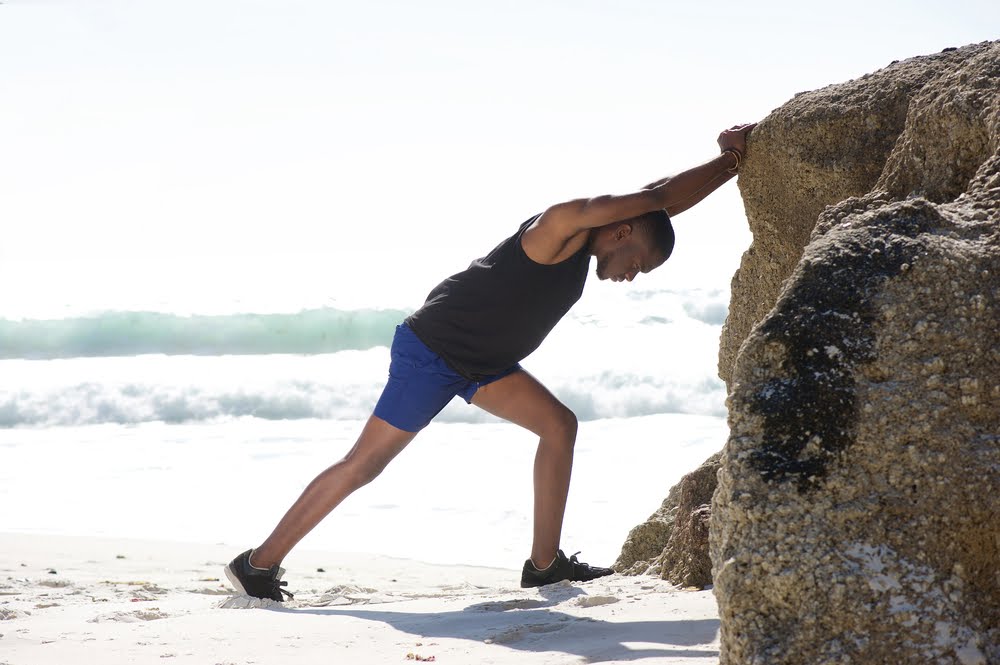A sedentary lifestyle is one of the top risk factors for heart disease.
Fortunately, it is a risk factor that you can do something about. Regular
exercise, especially aerobic exercise, has many health benefits.
Regular exercise is the secret to
achieving higher energy levels, a strengthened
heart and cardiovascular system. It is the best way to burn calories and lower
blood pressure, improve muscle tone, strength, balance and joint flexibility.
achieving higher energy levels, a strengthened
heart and cardiovascular system. It is the best way to burn calories and lower
blood pressure, improve muscle tone, strength, balance and joint flexibility.
Each exercise session should consist
of three phases.
of three phases.
Warm-up
This helps your body adjust slowly
from rest to exercise. A warm-up reduces the stress on your heart and muscles,
slowly increases your breathing, circulation (heart rate) and body temperature.
It also helps improve flexibility and reduce muscle soreness. The best warm-up
includes stretching, range of motion activities and the beginning of the
activity at a low intensity level.
from rest to exercise. A warm-up reduces the stress on your heart and muscles,
slowly increases your breathing, circulation (heart rate) and body temperature.
It also helps improve flexibility and reduce muscle soreness. The best warm-up
includes stretching, range of motion activities and the beginning of the
activity at a low intensity level.
Conditioning
This follows the warm-up. During the
conditioning phase, the benefits of exercise are gained and calories are
burned. Be sure to monitor the intensity of the activity by constantly checking
your heart rate.
conditioning phase, the benefits of exercise are gained and calories are
burned. Be sure to monitor the intensity of the activity by constantly checking
your heart rate.
Cool-down
This is the last phase of your
exercise session. It allows your body to gradually recover from the
conditioning phase. Your heart rate and blood pressure will return to near
resting values. While cooling-down, do not sit, stand still or lie down right
after exercise as this may cause you to feel dizzy or lightheaded or have heart
palpitations. The best way to cool-down is to slowly decrease the intensity of
your activity. You may also do some of the same stretching activities you did
in the warm-up phase.
exercise session. It allows your body to gradually recover from the
conditioning phase. Your heart rate and blood pressure will return to near
resting values. While cooling-down, do not sit, stand still or lie down right
after exercise as this may cause you to feel dizzy or lightheaded or have heart
palpitations. The best way to cool-down is to slowly decrease the intensity of
your activity. You may also do some of the same stretching activities you did
in the warm-up phase.
YOUR
EXERCISE REGIME
Stretching:
 |
While performing stretching exercises, make sure your movements are
controlled and slow. Avoid quick, jerking movements; it should be gentle,
nothing painful. Stretch until a gentle pull is felt in your muscle. Hold each
stretch for 20 to 30 seconds. Stretch after you have warmed up or finished
exercising. This form of exercise is also very useful for breaking long periods
of inactivity at your desk.
controlled and slow. Avoid quick, jerking movements; it should be gentle,
nothing painful. Stretch until a gentle pull is felt in your muscle. Hold each
stretch for 20 to 30 seconds. Stretch after you have warmed up or finished
exercising. This form of exercise is also very useful for breaking long periods
of inactivity at your desk.
Aerobic and cardiovascular exercise
This type of exercise strengthens the heart and lungs and improves the
body’s ability to use oxygen. You can perform this exercise by running, jogging,
and biking. If you suffer from joint problems, choose a low-impact activity,
like swimming. The treadmill is also good for this form of exercise.
body’s ability to use oxygen. You can perform this exercise by running, jogging,
and biking. If you suffer from joint problems, choose a low-impact activity,
like swimming. The treadmill is also good for this form of exercise.
Strength training:
Use weights, dumbbells, bench-press, or your own body weight for
strength training. Do it 2-3 times a week. Allow your muscles recover for a day
between sessions.
strength training. Do it 2-3 times a week. Allow your muscles recover for a day
between sessions.
HOW OFTEN
SHOULD YOU EXERCISE?
Aim for at least 30 minutes of moderate-intensity activity “soldier
walk” or “brisk walking” for at least 5 days a week. If you are just getting
started, slowly build up to that. Over time, you can make your workouts longer
or more challenging. Do that gradually, so your body can fully adjust. When you
work out, keep your pace low for a few minutes at the start and end of your
workout. That way, you warm up and cool down each time.
walk” or “brisk walking” for at least 5 days a week. If you are just getting
started, slowly build up to that. Over time, you can make your workouts longer
or more challenging. Do that gradually, so your body can fully adjust. When you
work out, keep your pace low for a few minutes at the start and end of your
workout. That way, you warm up and cool down each time.
EXERCISE
PRECAUTIONS
If you are not sure of your heart condition,
seek your doctor’s opinion before you start to exercise. Also, in exercising, stop and
rest if you feel weak, tired, dizzy, light-headed, or if
you feel pressure or pain in your chest, neck, arm, jaw, or shoulder. You
should also stop if you have any trouble breathing.
It is normal for your muscles to be mildly sore for a day or two after
your workout when you are new to exercise. That fades as your body gets used to
it. Soon, you might be surprised to find that you like how you feel when you are
done.
your workout when you are new to exercise. That fades as your body gets used to
it. Soon, you might be surprised to find that you like how you feel when you are
done.
By John-Kennedy Nnanna


























